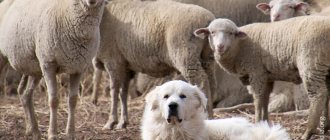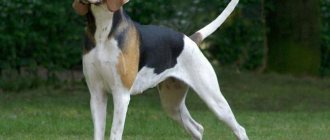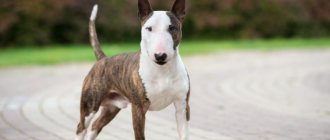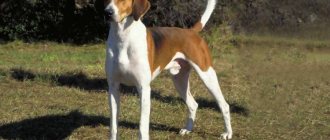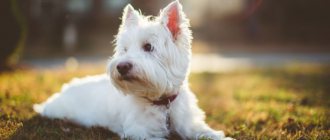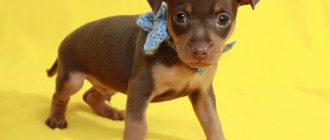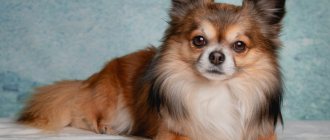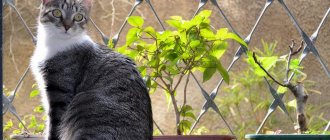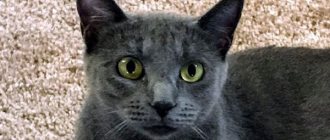The Pinscher is not a single breed, but a whole group consisting of five types of dogs. The largest among them are Dobermans, and the smallest are dwarf representatives. All these varieties are united by common features of appearance and temperament. Originally intended to guard and catch rats, today these dogs are wonderful companions and loyal friends.
General information about the origin of the breed
Pinschers belong to the group “Pinchers, Schnauzers, Molossians and Swiss Cattle Dogs”, the subgroup “Pinchers and Schnauzers”. These are service dogs that are quite suitable for training, and these qualities give reason to compare them with shepherd dogs.
The homeland of pinschers is Germany. Initially, they were moderately socialized dogs, excellent assistants to farmers and stagecoach owners.
There are two versions of the origin of the name of the breed. According to the first, the word “pinch” means “pinch”, “biter”. Traditionally, representatives of this breed had their tails and ears “plucked” (cropped). But it is possible that the second version is closer to the truth - a small, belligerent dog could not cause much harm, but it could easily pinch the leg.
The breed received official recognition in 1879 and immediately gained popularity in Europe. In 1895, German dog handlers founded the first Pinscher Club. Today there are five known species of pinschers.
Description of the breed, characteristics
This pet is classified as a service dog - after all, pinschers are highly trainable and learn quickly, which is why they are so popular among dog breeders. Although Dobermans seem aggressive, they are simply at the genetic level designed to protect their owners and their territory, and therefore do not allow strangers into their world. Especially if strangers or animals behave negatively. But at the same time, dogs of this breed are unusually devoted to their owner and are unusually attached to him.
Therefore, these animals are still used as watchdogs and security dogs in military units, warehouses and other facilities that require protection.
Many novice dog breeders confuse representatives of this breed with toy terriers, but these are two completely different varieties that do not have common roots. Although these animals were bred for different purposes, nowadays they are more favorites and companions of dog breeders. These breeds are similar in color, but in everything else they are very different from each other.
Athletic, powerful and large pinschers are quite active and love long walks with active games. Their powerful chest is one of the main differences from that of terriers, but the latter individuals have longer limbs.
The character of pinschers is also quite complex; they can be aggressive towards strangers, defending their territory. But they always show friendliness towards children.
And toy terriers are calmer and more balanced; they almost always show friendliness towards others, even if they see them for the first time. But if you don’t train these pets, the owners run the risk of raising a quarrelsome and constantly barking dog.
German
German Pinschers are considered the progenitors of all types of Pinschers, since they appeared in Germany back in the 18th century. The exceptions are Austrian and dwarf cats, with whom the “Germans” bred at the same time. It is believed that representatives of this breed descended from swamp dogs that were common in the southwest of the country.
Pinschers have a colossal capacity for work, which allowed them to tirelessly look after the owner’s property and run after carts. They were officially recognized in 1884.
Today, German Pinschers (standard) are not a common breed.
Visually, they are similar to both Doberman Pinschers and Miniature Pinschers, with the exception of size. Their height does not exceed 50 centimeters, weight - 20 kilograms.
The character of German Pinschers is kind, sociable and at the same time serious. Dogs are fanatically devoted to all family members, but they are very persistent and domineering, so they obey only a decisive and firm person. Harsh training methods are not accepted. Walking and physical activity are an integral element of education for them. The main feature of German pinschers is the ability to jump up to 1.5 meters in length.
Training and education
Training should begin at 4 months, and upbringing should begin from the very moment the puppy gets into a new family. After all, if you delay the start of the educational process, you can end up with a wayward and uncontrollable dog.
The basis of education must include training in basic skills:
- getting to know your own place;
- accustoming to a daily routine, diet;
- getting used to the leash and collar;
- training and consolidation of core teams.
The dog is very jealous of its things, even people - its owner and members of its family. It is necessary to teach your pet to calmly react to loss. Otherwise, all objects in the living area will belong to the pinscher, and not to the person. Also, in the absence of proper training, the dog will be able to rush at strangers or animals.
At the age of 5, male dogs may begin the so-called transition period. At this time, the dogs are trying to take over the family and gain leadership. Attempts at dominance should be strictly suppressed; there is no need to indulge your pet or ignore such antics. Within a few months, the aggression will disappear, and the pet will remain a loyal and good-natured animal - if you react to unusual behavior in a timely and correct manner.
You cannot punish or publicly scold a dog. This degrades her self-esteem. A pet's resentment can result in damage to valuable items.
Austrian
The Austrian Shorthaired Pinscher was bred in Austria from local dogs and old-type pinschers. This breed, officially recognized in 1928, is practically unknown outside its homeland.
Medium-sized dog: height at the withers - 40-50 cm, weight - 16-18 kg. The body is squat, strong, the tail is densely covered with hair and curls into a ring. The coat is thick, short, close to the body, with undercoat. Common colors include fawn, reddish-brown, and black with red spots. White markings are allowed on the chest, muzzle and tip of the tail.
The character of Austrian Pinschers is cheerful and energetic, but they are too stubborn and prone to dominance, so they are very reluctant to recognize leadership in a person. Possible difficulties in training. Representatives of this species are successfully used for hunting rabbits and foxes. For a dog to develop harmoniously, it needs space and good physical activity.
FCI classification
All representatives of Pinschers belong to group No. 2 according to the FCI classification, which, in addition to them, includes schnauzers, Swiss cattle dogs, molossoid dogs and mountain dogs. Pets of this species belong to section No. 1; the birthplace of most breeds is Germany.
Pinschers were originally bred to fight rats and mice and lived on farms and stables.
The name given to the breed comes from the word "pinch", presumably due to the fact that the pets' ears and tails were cropped.
The first representatives of pinschers were medium-sized dogs; a little later, large varieties were bred to protect homes and property, and then miniature ones, which acted as companions and family pets. After crossing with terriers and some other breeds, pinschers became the basis for breeding schnauzers, from which they were completely separated only at the turn of the 19th and 20th centuries.
Currently, all pinschers can live in an apartment as a pet; some successfully serve in law enforcement agencies.
The entire group has a similar appearance:
- Short, shiny coat, often black and tan;
- Elongated muzzle with strong teeth;
- Muscular but dry body;
- Drooping or cropped ears.
These are dogs with a strong character, energetic, active, and easy to train.
Affenpinscher
The Monkey Pinscher, as this breed is sometimes called, is very popular in its homeland of Germany and France. By the way, the word “affen” translated from German means “monkey”.
Belgian griffins, pinschers, pugs, as well as rural dogs of the schnauzer type took part in the formation. Affenpinschers received official recognition in 1896.
A distinctive feature of representatives of this breed is a small and flat “monkey” muzzle, long, shaggy and coarse hair with a thick undercoat (its length is 2.5 cm). The dogs are medium in size. Their weight is no more than 6 kg, height - 28 cm. According to the standard, the color can only be black.
The character of Affens is active, strong-willed, and stubborn. Despite their small size, they are very brave and zealously protect the territory and property they own, and can show aggression. Not recommended for families with small children. They need long walks and physical activity.
Existing varieties of pinschers
According to the FCI standard, pinschers are included in the same section as schnauzers. These dogs are a variation of them obtained by crossing Wire Coated Pinschers and Terriers. At the end of the 19th century, schnauzers were considered a separate breed.
Most of the recognized pinschers are smooth-haired. Exceptions include the Affenpinscher and the Austrian Shorthair.
Dwarf or miniature
The Miniature Pinscher is one of the miniature representatives, bred by crossing German Pinschers with Dachshunds and Italian Greyhounds. Despite the lack of a direct family connection, the appearance of the four-legged dog is almost identical to the Doberman Pinscher. The main difference is height and weight, which are 25-30 cm and 4-6 kg, respectively.
Miniature pinschers are distinguished from other pinschers by their longer limbs, which provide record jumping ability. The maximum height of his jump is 5 times his height!
Despite its modest dimensions, the miniature pinscher is very hardy and fearless. Initially, it was used exclusively for exterminating rodents, but then it was also adapted to accompany crews.
Doberman
Doberman is the largest representative. Its maximum weight reaches 45 kg. The dog received its name in honor of its founder, Karl Friedrich Louis Dobermann.
When breeding the breed, the emphasis was on an angry disposition, fearlessness and trainability. These qualities made it possible to use the new pinscher for work in the police, where he was involved in the search and detention of criminals.
In addition to its impressive size, the Doberman is distinguished from other pinschers by its elegance. The outlines of his body are as harmonious and graceful as possible, which makes it difficult for unscrupulous breeders to deceive him. Thanks to its impeccable anatomical structure, any flaw is immediately noticeable.
German
The genes of the German Pinscher are present in every recognized species, since this dog is the ancestor of the breed. There is no exact information about its appearance, but, according to research, the closest relative of the quadruped is the Lagotto Romagnolo, or Italian water dog. Initially, dogs were bred for hunting and protecting private property, and then they were introduced to guarding mobile cargo.
Due to World War II, the number of German Pinschers was reduced to 7 individuals. The breed was preserved only thanks to the efforts of breeders. The size of this dog is larger than that of a miniature, but smaller than that of a Doberman. Otherwise, it is almost identical to them.
Affenpinscher
The weight and height of the Affenpinscher are the same as that of the Miniature Pinscher. This is the most unusual representative among pinschers. It is distinguished by long, coarse hair, the presence of a fluffy beard, expressive eyes and hanging ears that are not docked.
At first glance, this funny four-legged creature looks more like a monkey than a dog. The amazing resemblance to primates is even spelled out in the name of the breed, since the German word affe translates as “monkey.”
The main purpose of breeding Affenpinschers was to hunt rodents, but European aristocrats quickly promoted these adorable little ones to companions. When creating these pinschers, pugs, griffons and schnauzers were used.
Austrian Shorthair
Like the Affenpinscher, the Austrian Shorthaired Pinscher is also a strong breeder. Despite its close relationship with the German Pinschers, Austria is considered its homeland. In Russia it is almost impossible to find representatives of this breed.
Austrians use this dog for a wide variety of work:
- fox hunting;
- protection of livestock and property;
- extermination of rodents.
Another important difference is the presence of a thick undercoat and developed guard hair. These qualities are necessary for working as a shepherd in adverse weather conditions.
Doberman
This type of pinscher was bred in the mid-19th century by Friedrich Louis Dobermann, in whose honor the breed got its name. Dobermans are nothing more than an enlarged copy of miniature pinschers. To form the breed, German pinschers, Beaucerons, Rottweilers, as well as some types of hunting dogs were involved. Reached official recognition in 1863.
Dobermans are characterized by a strong physique, which combines strength, grace, and proud posture. These are large dogs, whose weight varies from 35 to 45 kg, height at the withers - from 60 to 70 cm. The coat is short, thick, straight, without undercoat. The standard allows only two colors - black and brown.
Dobermans have a very temperamental character, but they are too smart to show their emotions. These are unusually brave dogs, excellent guards and devoted companions to humans. In case of danger, they always fight back the ill-wisher. They have high intelligence and are easy to train, which allows them to be used for work in government agencies - police, customs.
Affenpinscher: history of origin, description and care recommendations
This is one of the oldest European breeds, the first mention of which dates back to the beginning of the 16th century. The official homeland of the Affenpinscher is the German port town of Lubeck, formerly part of the Hanseatic League. They were originally bred to kill rodents. According to experts, Brussels griffins, certain varieties of terriers and even Asian pugs took part in the formation of the breed. Be that as it may, today these interesting creatures enjoy the well-deserved love of world breeders and ordinary owners. In many cities there are nurseries for pinschers with the original monkey face.
These are small compact animals, whose height is 20-28 cm, and their weight ranges from 3.5-6 kg. On the dome-shaped head with a convex forehead and pronounced stop, there are huge round eyes and high-set ears. Under the square, muscular body with a straight topline and a developed, slightly flattened chest, there are two pairs of smooth, strong limbs. The entire body of the Affenpinscher is covered with coarse black hair. The animal's face must have sideburns, a beard and bushy eyebrows.
The Affenpinscher is an unpretentious dog that easily adapts to any living conditions. The only inconvenience associated with caring for this animal may be the need for regular trimming. Also, the owners of such a dog should be prepared for the fact that they will have to systematically trim the hair around their pet’s eyes. Otherwise, the dog will begin to lose vision.
Despite its miniature size, the Affenpinscher is very energetic. Therefore, he should have the opportunity to splash out the accumulated energy on walks in city parks. At the same time, it is recommended to protect him from contact with larger brothers so that they do not accidentally injure him.
If, after reading the above material, you decide to purchase such a puppy, we recommend that you contact a specialized nursery or a professional breeder. Because this is the only way you will be completely sure that you are paying a lot of money for a purebred puppy with all the relevant documents, and not buying a pinscher cross, from which anything can grow.
miniature pinscher
In Germany, miniature pinschers began to be bred at about the same time as the German ones. These babes instantly became popular both in their homeland and abroad. And this fact is explained not only by its attractive exterior, but also by its talent in terms of catching rodents and selflessly protecting the owner’s property. Today they are just adorable dogs that have turned into pets. The first miniature pinscher fan club was opened in 1895 in Germany.
Miniature Pinschers are very temperamental, and their aggression and tendency to fanatically guard their territory sometimes leads to problems. They are unusually active and mobile, it feels like they have a hidden motor inside them that allows them to move continuously. Dogs are quite intelligent and quick-witted, but they are difficult to train and show at shows due to their excitability and excessive energy.
Externally, dwarf pinschers are similar to Dobermans, but have miniature sizes: weight - up to 6 kg, height - up to 30 cm. Colors: red, brown, black and tan.
Video "Miniature Pinscher and Doberman"
There is no doubt about the similarity of all dogs of this breed group. And you can make sure again by watching this video.
Was this article helpful?
Thank you for your opinion!
The article was useful. Please share the information with your friends.
Yes
No
X
Please write what is wrong and leave recommendations on the article
Cancel reply
Rate the benefit of the article: Rate the author ( 4 votes, average: 4.50 out of 5)
Discuss the article:
How to buy a puppy
It is advisable to purchase a pinscher puppy from nurseries, where they will provide all the necessary documents for it and inform the future owner about the specifics of feeding and vaccinations.
The puppy must be active, inquisitive, and friendly. Excessive aggression, cowardice, and lethargy are not acceptable. But the most important thing, of course, is health. The future family member should have shiny, glossy fur, clear eyes, straight strong legs, and a moderately well-fed tummy.
The cost of German and miniature pinscher puppies is 20,000-25,000 rubles. However, if buying miniature pinschers due to their popularity does not present any difficulty, then German ones are rare for Russia. Dobermans are a little more expensive - from 25,000 to 40,000 rubles. The price for Austrian Pinscher puppies is even higher, on average - from 40,000 rubles. The most expensive are Affenpinschers. A puppy from a kennel will cost the future owner 70,000-100,000 rubles.
Photo gallery
Finally, you can take another look at all the breeds that make up the Pinscher group. Starting from the largest - the Doberman pinscher and ending with the smallest - the miniature pinscher.
Health, illness
In general, pinschers are considered hardy and healthy dogs with strong immunity. The average life expectancy is 10-15 years (depending on the species: for Dobermans - 10-13 years, for Affenpinschers - from 12 to 14 years).
The most common diseases include:
- dysplasia of the hip and elbow joints;
- dislocations of the knee joints;
- Legg-Peters disease (joints) and, as a complication, arthritis;
- Wobbler syndrome (spinal cord pathology characterized by impaired coordination of movements);
- thyroid disease (hypothyroidism);
- ophthalmological diseases (cataracts, glaucoma, etc.);
- heart murmurs;
- skin diseases (dermatitis, allergies).
Liver pathologies are common among Dobermans, as representatives of this breed are prone to bloating. Miniature Pinschers are prone to congenital deafness, obesity and epilepsy.
Advantages and disadvantages
Any breed has its pros and cons. Miniature Pinschers are no exception.
The positive features are:
- No need to worry about being late at work or getting up at 6 am to go for a walk. The Pinscher is litter trained and does not need to wait for its owners for urgent matters. It also prevents the development of diseases of the urinary system.
- Small size is a clear plus when kept in a small apartment.
- Easy to train.
- Gets along easily with children.
- A lively mind allows you to analyze the situation, choosing the best solution.
Besides this, there are also disadvantages:
- The dog loves to chew on everything he finds.
- Does not tolerate prolonged loneliness well, as a result of which he can cause a pogrom in the apartment.
- He loves to dig up everything he can - from flower beds and beds to pots of indoor flowers.
- May suddenly start barking at both passers-by and other dogs due to guarding personality traits. If it is enough to apologize to people, then you will have to defend yourself from large dogs.
However, it's not all bad. These shortcomings can easily be eliminated from a dog’s behavior with simple training and proper upbringing.
Content
Pinschers are easy to care for. Hygiene procedures boil down to weekly combing or wiping the short coat with a damp mitten. Bathe them when they get dirty.
Affens, which, unlike other types of pinschers, have long hair, need to comb their coat once every 2-3 days using a furminator, and bathe once every 2-3 months. To keep the coat looking neat, it is advisable to visit a grooming salon. You can't cut your hair, they will look awkward.
For all types of pinschers, the necessary hygiene procedures are daily wiping the eyes with a damp disc, cleaning the ears and trimming the nails once a week.
You need to walk often and for a long time so that the dog is properly tired; this breed is unusually active. Walks - 2-3 times a day, lasting at least 2 hours. You can let your dog off the leash only when he learns to adequately respond to commands and carry them out.
Short-haired pinschers tolerate heat well, but in cool weather they may experience discomfort. For the autumn-winter season, it is advisable to purchase warm clothes.
Character
Briefly describe the German Pinscher using the following definitions: family-oriented, intelligent, energetic, friendly, balanced, loyal and very cheerful.
The excess energy and innate hunting instinct of the German Pinscher suggests that such a dog requires competent control and proper education.
The pinscher does not tolerate discourtesy, he is a zealous owner and does not like to share his own: toys, food, a bowl of water... Therefore, it is important to establish a trusting relationship between the pet and household members.
The pinscher will not attack first. In response to an attack, he will respond with all fury, defending his territory, himself or family members with their property. He is wary and distrustful of strangers.
If there are small children in the family, they should not be left alone with the Pinscher. The dog is very active and can harm the baby with its movements. Teach older children the correct attitude towards the Pinscher. The pet will not tolerate children's pranks for long; it demands respect and justice. If a child establishes a relationship with a German Pinscher, the dog will become his best friend, a faithful guard and a tireless play partner.
Gets along well with pets. But it is not recommended to keep small rodents (rabbit, guinea pig, ferret...) in the same area together with an ideal rodent hunter.
It is worth listing the character traits of the German Pinscher: cunning, manipulator, adventurer, dominator.
Excessive kindness during training and raising a pet is unacceptable. You risk raising a spoiled, wayward, uncontrollable dog that will cause a lot of trouble for its owners.
The Pinschers family: historical chronicles
Mentions of the Rutter, later renamed the “medium” Pinscher, have been regularly found since the second half of the 16th century. It is generally accepted that the blood of the famous turf dogs, Biberhund, Tanner, and black-brown terrier, took part in the formation of the physical and personal parameters of the breed.
Swabian breeders made a universal working dog. Practical Germans needed a “farmer’s versatile and talented breed”: unpretentious in maintenance and nutrition, capable of performing security and guard duty, capable of working in the pastures as a shepherd, and (as a pleasant bonus) serving as a gun dog on the hunt.
Reflecting on the etymology of the term “pinscher”, dog linguists consider two versions that have the right to life:
- from the English colloquial term pinch, alluding to the tradition of docking (pinching) dogs’ ears and tails;
- from the old German pinched (to pull, squeeze), focusing on the method of attack of German dogs, when the dog, often biting the victim, shakes its head vigorously.
The new breed fit perfectly into the life of ancient Germany: possessing amazing working qualities, the dogs clearly fit into the canonical German concept of “Ordnung”. All types of pinschers , in addition to their demonstrative hard work, are famous for their uncompromising focus on the owner, excellent obedience, diligence and organization.
